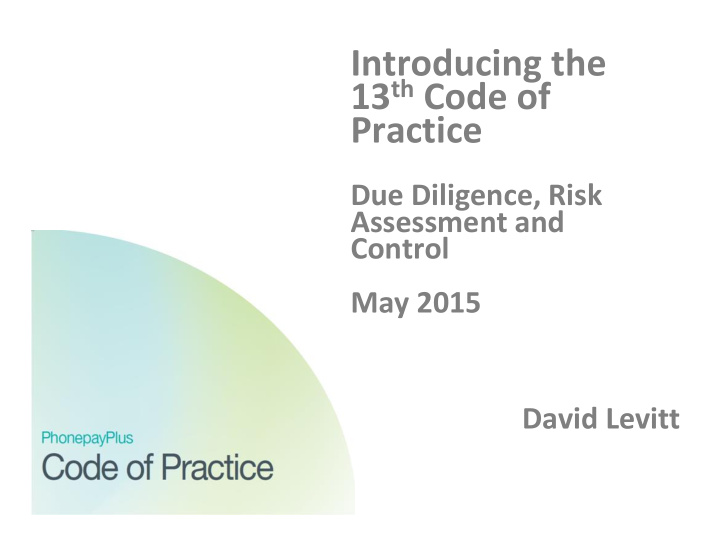



Introducing the 13 th Code of Practice Due Diligence, Risk Assessment and Control May 2015 David Levitt
Overview of Code 13 seminars
Objectives of DDRAC seminar • As a refresher for those who are experienced • Introduce DDRAC to new faces • Share good practice • Educate as to changes in the DDRAC Guidance • Highlight Code 13 changes which might affect existing DDRAC processes
Code provisions on DDRAC • Paragraph 3.3.1 – All Network operators and Level 1 providers must perform thorough due diligence on any party with whom they contract to provide PRS, and retain relevant documentation as appropriate • Paragraph 3.1.3 – All Network operators and Level 1 and Level 2 providers must assess the potential risks posed by any party they contract with, and take and maintain reasonable ongoing steps to control that risk
Guidance on DDRAC • Created to support 12 th edition of the Code • Sets out expectations around Due Diligence, Risk Assessment and ongoing Risk Control • Changes recently consulted – Restructuring for clearer presentation – Addition of existing expectations for DDRAC on Affiliate Marketers – Final version of Guidance to be published in June 2015
Outcomes of DDRAC • Prevent customer harm arising from premium rate services • Protect the reputation of the PRS industry as a whole • Protect providers from being exposed to regulatory risk by their clients • Assist contracts which appropriately ensure expectations within the Code are met
The 4 steps to DDRAC • Know Your Client • Properly Identify Risks • Action to Control Risks • Responding to Incidents
Know Your Client • Due process for due diligence – Consistent approach taken – Tailored to the relationship being considered – Timed so that checks are completed prior to consumer impact • Preventative – Prevents harm arising • Preparatory – Prepares for later risk management activities
Properly identify risks - goals • Identify risks associated with each client and their services, considering all the circumstances • Prepare for handling any problems which may arise • Effectively managing provider exposure to risk
Properly identify risk - expectations • Assess key indicators that a client might be a high risk provider • Assess client’s track record • Check the names of directors and key individuals against previous regulatory sanction • Check how an L1 client controls risk “beneath” it • Check how an L2 client will promote and operate their service, and what it will provide
Properly identify risk – Affiliate Marketing • Assess whether affiliate network takes compliance seriously • Assess whether affiliates can, and will, identify and deal with sources of rogue traffic • Assess whether you have appropriate mechanisms and monitoring to identify and capture unusual activity
Breakout Questions 1) What sort of risks would you look to identify? 2) What are the drivers for those risks? 3) At what stage would you assess the client’s compliance history?
Action to Control Risk - goals • Formulation of action plans for monitoring and other risk control, which are appropriate to individual clients
Action to Control Risk - expectations • Appropriate, periodic testing and the recording of this activity • Mystery shopper exercises as appropriate • Whistleblowing mechanisms for staff • Systems that flag unusual traffic or other activity, and flag complaint spikes • Alter specific client action plans if level of risk changes
Breakout Questions 1) What fields of information would you record from testing activity? 2) How can records best be presented to ensure good internal and external communication?
Responding to Incidents • Calm, quick, proactive response • Work closely with PhonepayPlus and Networks • Document all activity in response to a problem – what and when? • The more that’s been done to prepare, the quicker and more effective the response will be
Changes which affect existing DDRAC • Consumer vulnerability – – think about any potential effect when assessing service proposals: necessary avoidance steps taken? • Complaint handling – – Have measures been put in place? – Is the process accessible? Is it effective? • Separate session on complaint handling on 15 July 2015
Changes which affect existing DDRAC • Special conditions – – Responsibility shared with industry – Prior permission no longer a litmus test – Focus shifts to understanding the relevant categories – Within any risk assessment process, treat Special conditions as part of the Code • Separate session on Special conditions on 24 June 2015
Risk management Institute of Risk Management Taken from CMA’s “ Competition Law Risk – A short guide ”
www.phonepayplus.org.uk Any questions?
Recommend
More recommend